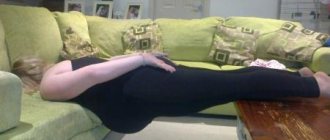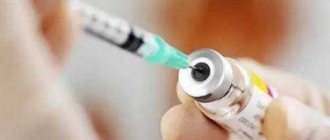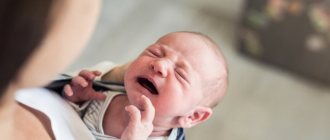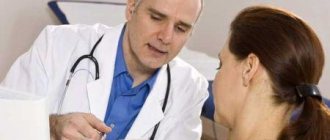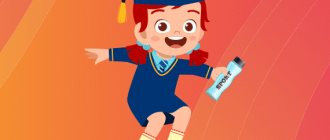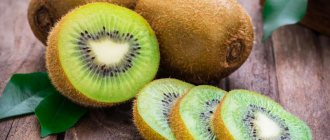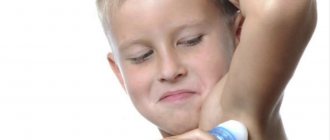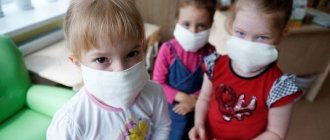As soon as she becomes a mother, a young woman suddenly comprehends the full human responsibility that she bears for herself and the baby she gave birth to. The main thing a good mother can do to really help her child in the first months of his life is to be there and be healthy. Protect yourself from poor health, and your child, so tiny and defenseless, from dangerous viruses and an aggressive environment.
Nature is designed in such a way that the best building material for a baby’s not yet strong immune system is mother’s breast milk.
. However, at the same time, the period when the baby is still small, the mother has not recovered from the difficult process of childbirth, there is not enough sleep, her head hurts, and her stomach is tight. In a word, it’s hard, and your hand reaches out for a no-shpa tablet. Stretches and stops: will no-spa harm the baby when breastfeeding?
Is lactation a contraindication to taking noshpa?
Based on the fact that it is inhumane to conduct research on such a reference group as pregnant and lactating women, as well as small children, we still do not have an exact answer to the question “is it possible to use noshpu while breastfeeding.” However, this drug has been known for more than 50 years. During this time, researchers could collect a lot of data on the effect of no-shpa on humans
, direct and collateral.
The drug no-shpa is an imported analogue of drotaverine, produced by an Indian company. A no-shpa tablet will help with spasms of the intestines, stomach and, of course, the uterus, which is especially important for women in the postpartum period.
When choosing medications during breastfeeding, a woman can be guided by some tables of the level of danger of drugs during lactation
.
Is No-shpa allowed during breastfeeding?
Almost all drug manufacturers do not recommend taking them while breastfeeding. Primarily because studies on the drug’s compatibility with breast milk and undesirable effects on a newborn are very rare. This also applies to the use of No-shpa during breastfeeding. Manufacturers indicate that due to insufficient clinical studies of the drug, No-shpu should not be taken during lactation. However, data on the compatibility of No-shpa during lactation can be found in the specialized reference book of Professor of Pediatrics Thomas Hale, as well as in the reference book “On the effect of medications on pregnancy and breastfeeding” edited by O.I. Karpov. and Zaitseva A.A.
Also, special services have been created for nursing mothers, for example, the e-lactancia online directory or the Forum of the Association of Lactation Consultants, where you can get information about the possibility of taking medications during lactation. It is very important for nursing mothers to receive such information, so that later, when trouble happens, they can take the pill without fear and not be tormented by remorse: “Maybe I was wrong..?”
How to drink noshpa so as not to harm the child
The main thing to remember when using no-shpa during lactation is that, like any product that enters the mother’s body, it is absorbed into the blood and penetrates into breast milk. You need to focus on the timing of absorption of the drug into the blood. The annotation to the noshpa states that the maximum concentration of active substances in the blood
observed after 45–60 minutes. Therefore, when taking noshpa once, it is worth adjusting with feeding, so that after taking the medicine more than 2 hours pass before the next feeding. For example, you can feed your baby and immediately take a noshpa tablet. If a nursing mother skips one feeding after taking the medicine, giving the baby prudently expressed milk in advance, then no-spa will not harm in any way.
Any medication taken, especially during breastfeeding (breastfeeding), should be agreed with your doctor. In a situation where we are talking about a nursing mother, it is also worth consulting with a pediatrician. If the doctor prescribes a course of No-Spa, you should stop breastfeeding at least for the duration of treatment. Since the components of noshpa tend to accumulate in the body of a woman and child, and in accumulated doses they are no longer safe at all.
You can try to maintain lactation. Regular pumping will stimulate milk production. Naturally, you do not need to give expressed milk to your baby. During the course of taking No-Spa, the baby must be switched to artificial feeding.
Analogues of No-shpa when feeding a child
After talking with your doctor, you can choose a more harmless analogue with fewer side effects. Options for replacing No-shpa when feeding a child can be drugs based on mebeverine (Mebeverine, Duspatalin) and pinaverium bromide (Dicetel). A direct analogue is Drotaverine.
- Available in the form of tablets and solution for injections;
- has contraindications and side effects similar to No-shpa;
- limited use in pregnant women and during breastfeeding.
- active ingredient - mebeverine;
- side effects are very rare;
- Contraindications include severe sensitivity to the elements of the drug;
- In small dosages, mebeverine is not absorbed into breast milk; use during breastfeeding is not prohibited.
When will noshpa help?
Effect of the drug
in tablets it begins within 20 minutes. Having decided on the relative safety of a single dose of noshpa, it is worth thinking again and understanding whether this medicine will help in a particular situation.
Since the action of noshpa (drotaverine) is aimed exclusively at smooth muscles, the effect of taking the tablets will occur only when the pain was due to spasm of the smooth muscles. In humans, these are usually hollow organs: stomach, uterus, bladder, intestines.
Taking the drug noshpa for toothache is considered unjustified. Of course, he won’t make things worse, but he won’t help either.
In case of abdominal pain, noshpa, unlike other antispasmodics and analgesics, will not erase the picture of an acute abdomen. But if you have any doubts, it is still better to consult a doctor
, and maybe even call emergency help. Generalized abdominal pain can be life-threatening.
When you definitely can't
Contraindications to the use of Noshpa are based on the experience that pharmacists have gained over 50 years of using this drug.
You should not take no-shpa when you have:
It is worth weighing the pros and cons before taking a noshpa tablet for a person with low blood pressure. This is due to the fact that noshpa, having a relaxing effect, will relieve vasospasm. Without this, low blood pressure may drop completely.
The effect of reducing blood pressure should also be remembered in relation to an infant. During breastfeeding (breastfeeding), drotaverine accumulates in the baby's body. Your blood pressure may also decrease.
Antispasmodics and analgesics
Pain is different, and you have probably encountered such a phenomenon that choosing some kind of painkiller became a waste of money and it was not possible to relieve an attack of pain with its help. A drug such as No-shpa relieves spastic pain and belongs to the group of antispasmodics. In addition to antispasmodics, analgesics are widely used to relieve pain syndromes. What is better for pain caused by spasms - antispasmodics or analgesics?
Spastic pain accompanies spasms of the smooth muscles of hollow internal organs (gastrointestinal tract, urinary and biliary systems), as well as spasm of cerebral vessels. It lasts from 20 minutes to 4 hours. Most often it is a consequence of premenstrual syndrome, chronic diseases of the gastrointestinal tract such as peptic ulcers, and dietary errors.
Such pain is dealt with by antispasmodics, which relax the muscles and relieve spasm and the pain caused by it. Antispasmodics are divided into two groups - neurotropic and myotropic. Neurotropic agents affect the nerve impulse transmission system, stimulating the tone or relaxation of the smooth muscles of internal organs.
Myotropic drugs directly affect the smooth muscle cells of internal organs, changing the biochemical processes occurring in them. This group also includes noshpa, often prescribed to relieve painful spasms and relax the muscles of the internal organs during pregnancy and breastfeeding.
There are also herbal antispasmodics - chamomile, tansy, mint, oregano, etc.
Analgesics eliminate any pain by blocking the pain center in the brain. If the pain is caused by a spasm, then their use is not justified. They do not eliminate the spasm, and the clinical manifestations of the inflammatory disease can be erased, which is already dangerous.
Many drugs are prohibited for use during breastfeeding, since their active components can penetrate into mother’s milk and with it into the baby’s body. This can cause allergies in infants, stool problems, poisoning and more serious health problems. Sometimes there is a question about the advisability of using No-shpa during a given period, although the instructions say about limiting use during breastfeeding. But there are some situations when No-shpa is allowed for nursing mothers.
After delivery, many women begin to experience pain in the lower abdomen and pelvic organs. This can be explained by the fact that spastic contraction of the genital muscles occurs in this area. Spasms contribute to disruption of the outflow of blood from the birth canal, which often causes the development of septic complications. It is No-shpa during breastfeeding that is considered an effective remedy suitable for such cases.
In addition, No-spa can have an analgesic effect during breastfeeding. Its effectiveness has been proven for headaches and abdominal discomfort. Still, despite the existing contraindications for use, there are not so many of them in comparison with other means. To avoid dangerous consequences in the form of side effects, read the instructions before using the drug.
The drug 'No-shpa' during breastfeeding - can I take it?
It is no secret to anyone that there is a well-known recommendation that says that a pregnant woman and a nursing mother should ideally not take any medications. But real life is far from the recommendations of experts, so in practice we have to deal with cases where the antispasmodic drug “No-shpa” is prescribed during breastfeeding.
The medicine "No-shpa" is a safe and effective antispasmodic
In the postpartum period, almost every woman experiences unpleasant painful sensations in the abdomen and pelvic area. The cause of these unpleasant symptoms is uneven contractions (spasms) of the internal genital organs in the postpartum period. Such spastic contractions can disrupt the outflow of secretions from the birth canal, which can provoke postpartum septic complications. That is why doctors prescribe the antispasmodic “No-shpa” during breastfeeding.
This drug, when used once in a therapeutic dose, has a negative effect on a newborn and a breastfed child. That is why, with short-term intermittent administration of the drug, there is no need to wean the baby from the breast. The drug “No-shpa” is excreted into breast milk during lactation and, accordingly, enters the baby’s body, but short-term use of the medication does not affect the respiratory and vasomotor center of the baby’s body.
What to do if the medicine “No-shpa” is prescribed for a long course?
Very rarely does a situation arise when a nursing mother must take this drug for a sufficiently long course. In this case, No-Spa can be prescribed for breastfeeding, but the doctor who monitors the mother and her child should advise whether it is worth continuing breastfeeding.
If the mother’s condition requires a short-term course of treatment - no more than 2-3 days in a row and there is hope for maintaining breastfeeding, then the newborn or infant should be transferred to feeding with formulas that replace breast milk, but only from a spoon or syringe. If the mother's condition requires a longer course of treatment, then prescribing No-Spa during breastfeeding in the vast majority of cases requires cessation of natural feeding. This is explained by the fact that some components of the tablets or solution for parenteral use may have undesirable toxic effects on the child’s body. That is why this effective antispasmodic is not used in pediatric practice in early childhood - the drug is not prescribed to children under 6 years of age.
In what form is it better to prescribe the drug “No-spa”?
It must be remembered that the medicine “No-shpa” during breastfeeding should be prescribed only by a qualified doctor who monitors both mother and child. An exception to the rules can only arise if a nursing woman is absolutely sure of the cause of her illness, has previously taken this drug on the recommendation of a doctor, and her condition does not require systematic use of this drug.
There is no particular difference whether the medicine “No-Spa” will be taken while breastfeeding in the form of simple tablets, the drug “No-Spa Forte” or in the form of injections - in any case, the components of the drug are secreted into breast milk, accumulate in it and enter the child’s body with natural feeding. There is a rule that states that the doctor must balance the possible risk for the baby and the benefit for the mother and reduce the negative aspects of using the drug to a minimum. It must be remembered that the popular opinion, which advises taking this antispasmodic to regulate milk secretion, can be of bad service - the risk of a negative effect of the drug on the child’s body when taken systematically is too great.
fb.ru
pharmachologic effect
Among the main components of the product is drotaverine hydrochloride, an isoquinoline derivative. This substance is a strong antispasmodic and acts on the smooth muscles of the body.
The main active substance helps stimulate dehydration of muscle tissue, reducing the intensity of the inflammatory process. Due to the relaxation of smooth muscles, blood circulation in the internal organs improves
. Drotaverine restores natural peristalsis in the digestive tract and helps eliminate pain in this area.
Thanks to long-term practice, I was able to study in detail the effectiveness of No-shpa on many patients, including women breastfeeding their babies.
No-spa during breastfeeding also helps to reduce the tone of the uterus
, thereby causing it to contract faster and return to its natural state after childbirth.
The effect of the medicine is not long in coming: according to numerous data, a decrease in pain intensity occurred within 30 minutes after taking the pill.
There were also cases when it was necessary to take the drug in a course. For this period, breastfeeding was stopped, but upon completion of the course it was restored. Despite the effectiveness of the drug, it is still worth considering contraindications.
Drotaverine does not smooth out the clinical picture of any inflammatory process and does not affect the sensitive mechanism in the body, unlike the action of other analgesics.
Release form
No-shpa is presented in the form of tablets that have a greenish or orange tint, and are round, biconvex in shape. They are engraved with “spa”.
Forms of release of the drug:
- blisters of 6 pieces per pack;
- blisters of 10 pieces per pack;
- blisters of 24 pieces per pack;
- in bottles of 60 pieces, which have a piece dispenser;
- in bottles of 100 pieces, which have a polyethylene stopper;
- in ampoules of 2 ml.
The bottom tablet contains the active substance drotaverine in a volume of 80 mg. Among the auxiliary components, it is worth highlighting magnesium stearate (6 mg), talc (8 mg), povidone (12 mg), corn starch (70 mg), lactose monohydrate (104 mg).
The bottom of the ampoule contains the main substance drotaverine in a volume of 40 mg. Among the excipients, it is worth highlighting such as sodium metabisulfite (E223), ethanol (E1510), and water for injection.
Indications for use
No-spa during lactation is used to relieve pain of various etiologies
, but only according to the indications of the attending physician. Using it you can eliminate:
- nagging pain in the lower abdomen caused by premenstrual syndrome;
- tension headache;
- postpartum spasm from the genitals;
- pain syndrome from smooth muscles of a spasmodic nature, which is localized in the intestines, stomach or other organs of the gastrointestinal tract;
- pain syndrome from smooth muscles, which is localized in the biliary tract.
In some cases, it can be used to eliminate pain in the spinal region.
, and there is a prolonged effect from its use (pain does not return for a long time). v
How to take No-shpa during lactation: safe dosage
I prescribe No-shpa to my patients, both during pregnancy and during breastfeeding. The drug acts quickly, especially when administered intravenously, thereby providing an analgesic effect.
Despite its high effectiveness, side effects sometimes occurred when taken orally.
– nausea, with intravenous injection – painful lumps at the injection site.
The drug copes well with discomfort caused by urinary tract diseases and gynecological pathologies. In addition, the medicine has a low cost and is accessible to every average person.
No-spa during breastfeeding is allowed to be taken both once and in a course. To determine the correct method of using a medicine, it is recommended to know the effect of its effect:
- If the tablet is taken once, the first positive changes in health occur after 20 minutes. The maximum amount of active substances in the body is observed 1 hour after taking the tablet. The concentration of drotaverine in the blood decreases after 3 hours. If it is necessary to take the drug during breastfeeding, this is done immediately after feeding in order to minimize the amount of active substances in the milk until the next lactation. How to restore lactation is the topic of the publication.
- If a medicine during breastfeeding is prescribed for course therapy, it is worth it. After finishing treatment, you need to express milk for some time and under no circumstances give it to your baby.
No-spa during breastfeeding: is it possible or not?
No-spa is a pharmaceutical medicine with clinically proven effectiveness. Laboratory tests and tests have shown that among the existing antispasmodics, No-shpa is one of the safest medications.
But the use of the drug during breastfeeding has not been studied enough. According to the official instructions, No-shpa does not have safe properties for a nursing mother - this is not the best option as a pain reliever, however, attending physicians and gynecologists often prescribe this drug to women during lactation.
Drostaverine belongs to unclassified (potentially dangerous, insufficiently studied) drugs [2].
Independent medical research college and hospital named after. R. G. Kar, Calcutta showed that drotaverine during pregnancy does not have a toxic effect on the embryo and does not cause pathologies or developmental abnormalities. It is a safe drug for both mother and child [1]. However, there is no reliable clinical data on the effect of the drug on the intensity of milk secretion, its quality, as well as on the safety of use during lactation.
The Association of Breastfeeding Consultants is of the opinion that there is a possibility that drotaverine passes into breast milk. With a one-time dose, No-Spa will probably not cause harm to health, but for long-term therapy, it is better for a woman to choose a safer drug.
Recommendations for natural feeding will help reduce the risk of undesirable effects from the use of No-shpa and minimize the effect of drotaverine on the child’s body:
- A one-time dose of No-shpa is safe if used for no more than three days. Course therapy is possible only in agreement with a gynecologist and pediatrician.
- There must be strict adherence to the treatment regimen and dosage. According to the instructions for use, it is prohibited to take more than 6 tablets of No-shpa (240 mg of substance); you can take no more than 80 mg at a time.
- To avoid the drug passing into breast milk, if possible, do not breastfeed your baby. Resumption of feeding should begin after the drug has been completely removed from the body, that is, two to three days from the date of the last dose. To replace meals, use pure expressed milk.
- A less drastic way is to replace the breasts 10-12 hours after taking No-shpa. During this period, the concentration of the substance in milk will become much lower.
- You can use a more gentle analogue and not give up the natural nutrition of the newborn.
Contraindications and side effects
Even despite the safety of using a product such as No-shpa when feeding a newborn, there are some contraindications to its use. First of all, this is hypersensitivity to the active components, the development of renal, liver and heart failure. Also, No-shpu is not used if hypotension develops
(lowering blood pressure).
- increased heart rate;
- strong pressure drop;
- increased sweating;
- impaired coordination of movements;
- symptoms of an allergic reaction (skin itching, rash, etc.);
- nausea and vomiting syndrome;
- dizziness.
Analogs
No-shpa analogues available in domestic pharmacy chains are summarized in the table:
| Drug name | Indications for use | Possibility of use for hepatitis B | Contraindications | Side effects |
| DROTAVERIN | Smooth muscle spasm caused by cholecystitis, cystitis, gastrointestinal pathologies, gynecological diseases, etc. | Can |
|
|
| NISPASMS FORTE | Pain caused by spasm of smooth muscles in diseases of the urinary tract, gastrointestinal tract, and pelvic organs. | As prescribed by the attending physician |
|
|
| BUT-H-SHA | Smooth muscle spasm caused by pathologies of the urinary tract, gastrointestinal tract, and gynecological diseases. | As prescribed by the attending physician |
|
|
| NOCHSHAVERIN | Smooth muscle spasm caused by diseases of the biliary tract, gynecological pathologies, gastrointestinal diseases. | As prescribed by the attending physician |
|
|
| PAPAVERINE | Smooth muscle spasm caused by pathologies of the biliary tract, pathologies of the blood vessels of the brain and heart. | As prescribed by the attending physician |
|
|
To summarize, it is worth concluding that any remedy must be agreed with your doctor before use during breastfeeding, including the birth control pills Lactinet or Charozetta. The specialist takes into account the potential benefits and possible harm to the child, and based on this, determines the most effective treatment.
The main active ingredient of No-shpa is drotaverine hydrochloride
, it can effectively reduce the tone of smooth muscles and dilate blood vessels, so relief comes quite quickly. The principle of action of the drug is reflected in its name: it translates as “no spasm.”
The active ingredient tends to pass into breast milk and is completely excreted from the body after about 72 hours, so before use, consultation with a specialist is required.
The instructions for the drug state that it is prohibited during breastfeeding
. This is due to the fact that the effect of the drug on the child’s body has not been fully studied. The manufacturer warns about this and does not guarantee complete safety.
Despite this ban, No-shpa is in demand among nursing mothers, especially in the first months after childbirth, when there is a gradual contraction of the uterus, accompanied by characteristic pain. Due to spasms, the outflow of blood from the pelvic organs is disrupted, which is fraught with complications, so doctors often allow women to take No-shpu without interrupting breastfeeding, but subject to short-term use and compliance with certain precautions.
Important!
If long-term treatment with the drug is required, the baby is transferred to formula, and after the end of therapy he can be put back to the breast.
The famous pediatrician E. O. Komarovsky is sure that the mother’s well-being has a great influence on the condition of her baby. If a woman feels severe discomfort due to pain, then she cannot fully take care of the child. In this case, the pill will not harm, but will bring relief, which will allow the mother to once again enjoy her important role in the life of the baby.
Is it possible to “No-shpu” while breastfeeding - detailed information!
Pregnancy, childbirth, and breastfeeding are natural processes that require special resources from the female body. Therefore, it is not surprising that women may feel unwell during this period. Often, a new mother suffers from headaches and spasms in the pelvic area and intestines. At the same time, she is afraid to take medications because she is breastfeeding. One of the painkillers with a pronounced antispasmodic effect is No-spa, which is often prescribed during pregnancy. Can it be used while breastfeeding?
What is the purpose of “No-shpa”?
“No-spa” is the commercial name of the medicine, the main component of which is drotaverine. Its action is aimed at relaxing smooth muscles, which leads to a decrease in the tone of internal organs, including the intestines, and dilation of blood vessels.
The drug has 2 release forms:
- biconvex tablets containing 40 mg of active ingredient;
- liquid for intravenous or intramuscular administration in ampoules containing 40 mg of drotaverine.
Tablets are used in everyday life.
Does the instructions allow taking the drug during breastfeeding?
Manufacturers do not recommend taking many medications to nursing mothers. This is due to the fact that manufacturers rarely conduct studies on compatibility with HB. In this regard, “No-shpa” is no exception. The instructions do not recommend combining the use of drotaverine with breastfeeding.
Other opinions on compatibility
Today, there are several main sources where you can find out about the compatibility of medications with lactation.
- Association of Lactation Consultants Forum.
- Directory of the American pediatrician Dr. Hale. It lists drug risks in categories.
- Electronic directory e-lactancia. To work with it, you need to know the Latin name of the active substance. The guide also breaks down risks into categories.
- A reference guide on the effects of medications on pregnancy and breastfeeding, published by O.I. Karpov. and Zaitsev A.A.
Below is a table containing data on the compatibility of “No-shpa” with lactation in accordance with the described sources.
Source name Data on the compatibility of No-shpa with HV Forum AKEV Compatible with HV Hale's Handbook Hale's Handbook Category L2 (safe, as either limited studies have not shown any negative effects or side effects are unlikely) e-lactancia No data on this drug Karpov's Guide
Thus, lactation and “No-shpa” are compatible. For greater safety, several rules must be followed.
Recommendations for the use of drotaverine for a nursing mother
Among all antispasmodics, No-spa is one of the safest. This medicine will help a young mother get rid of several problems:
- spasmodic pain in the intestines, kidneys, bladder, liver, for example, in diseases such as cholecystitis, renal or intestinal colic, inflammation of the duodenum and stomach, cystitis, etc.;
- painful menstruation;
- postpartum uneven contractions of smooth muscles in the genital area;
- headaches.
It is sometimes taken as a mild drug to lower blood pressure.
Despite the fairly high safety, you need to remember that No-shpa has contraindications. The drug should not be used in severe cases of renal, liver or heart failure, or high sensitivity to any component of the drug. Women suffering from low blood pressure should be careful when using drotaverine.
A nursing mother should also stop taking the drug if side effects occur:
- tachycardia;
moy-kroha.info
Before taking Noshpa, you need to take into account that its components easily pass into breast milk. Therefore, a nursing mother should be very careful about its use, especially if she has ever experienced side effects, or has individual intolerance. In the latter case, you need to stop taking this drug completely.
If there are no side effects or intolerance, then Noshpa is allowed.
However, only in a therapeutic dosage and for a single or double dose. In this case, there is practically no negative impact on the baby. And there is no need to interrupt breastfeeding during this period.
Long-term use of Noshpa and breastfeeding
You should take Noshpa under the supervision of a doctor.
If for some reason the doctor prescribed long-term use of Noshpa, then most likely you will have to stop breastfeeding for good.
The exception is a course of treatment from 2 days to a week, then during this period you can try to wean the child from the breast. This will help eliminate unwanted toxic effects on his body. And when the course of treatment comes to an end, you can resume breastfeeding again.
In any case, a nursing mother should not self-medicate. And any drug, including Noshpa, should be prescribed only by a doctor.
Liked?
aranetta.ru
Contraindications and side effects
The drug is not suitable for everyone; a nursing mother should not take the medicine in the following cases
:
- Bronchial asthma.
- Lactase deficiency.
- Hypotension, heart failure, arrhythmia.
- Kidney and liver failure.
- Hypersensitivity to the components of the drug or their individual intolerance.
The body of a nursing mother is weakened and can react sensitively to any chemicals, so there is a possibility of side effects:
- nausea, vomiting;
- dizziness, sleep disorders;
- decreased blood pressure, increased heart rate;
- impaired coordination of movements;
- increased sweating;
- allergic manifestations: itching, irritation, redness and others.
Attention!
If negative consequences occur, a woman should consult her doctor and stop using No-shpa.
Side effects from the drug can also affect the baby
, therefore, after taking the pill, you need to carefully monitor the child’s condition and examine the skin.
How does breastfeeding affect lactation and the baby?
The active substance drotaverine hydrochloride has the ability to penetrate into the blood, after which it is concentrated in mother’s milk and enters the child’s body. With a single dose of No-shpa, the likelihood of side effects is small, but with an increase in the dose and frequency of use, the baby may experience:
A nursing mother should continuously monitor the baby’s well-being in order to take timely measures.
Important!
If there are any negative consequences, the child needs medical attention and immediate cessation of taking No-shpa.
When breastfeeding, both short-term medication use and long-term treatment using No-shpa are allowed. Methods of therapy for lactation depend on the nature of the pain and have their own characteristics and dosage
.
One-time use
If a mother takes one tablet, it will not harm the child, since the concentration of active components will be low, and they will quickly leave the body naturally. Within 20 minutes after administration, a woman may notice an improvement in her condition and a decrease in pain.
The maximum volume of the active substance is reached after an hour, so it is better to take the tablet immediately after the next breastfeeding or before it. Compliance with this rule can significantly reduce the concentration of the drug in milk. The dosage for a single dose is 80 mg, which corresponds to one tablet or two 40 mg tablets. You can consume up to 240 mg of the drug per day
.
Long-term use
In special cases, doctors prescribe a course of treatment with No-Spa, since it does not affect the overall clinical picture and does not interfere with the diagnosis, while alleviating the patient’s condition. For serious illnesses, the drug can relieve pain, but the mother will have to temporarily stop breastfeeding so as not to harm the baby.
Milk must be constantly expressed to maintain lactation, and after completion of the course of treatment, with the permission of the doctor, natural feeding can be resumed. If long-term use of No-shpa is necessary, the dosage is determined only by a specialist
, based on the severity of the woman’s condition and the established diagnosis.
In what form should I use it?
The drug is available in two forms:
- Tablets of 40 or 80 mg
. They are convenient to take at home and in emergency situations for severe pain. This is the most common and accessible way of consumption. - 40 mg solution in ampoules
(for intravenous or intramuscular administration). It begins to act almost instantly, but is used primarily in medical institutions. Not recommended for self-treatment.
There is an almost unanimous opinion that medications should not be taken during breastfeeding. Not only experts, but also most mothers think so. But this is all theory, but in practice? What if a situation suddenly happened that you couldn’t do without medication? Let's say my mother is in pain, and usually under such circumstances she would drink no-shpa. How to proceed? Is this drug suitable for a nursing mother? After all, noshpa is one of the very effective remedies for pain and spasms. How will pills or injections affect the baby and breast milk? We will try to answer all these questions in this article.
Pain in the lower abdomen after childbirth is associated with the fact that the uterus contracts unevenly. They can lead to unwanted complications. And this is where no-spa can come to the rescue, as it very easily copes with difficulties of this kind. Therefore, doctors often prescribe it in such cases.
In addition to these problems, no-spa solves many others. This is a good pain reliever, so any pain from which a nursing mother is not immune has no chance. In addition, the medicine has few contraindications. But still, before taking it, you need to get to know this product better. And try to correctly assess the ratio of benefits for the mother and potential harm to the child.
No-spa when breastfeeding
The drug may have some effect on the baby, for this reason the woman must follow certain rules for using No-Shpa. This medicine has contraindications, so it is important to strictly follow the rules of administration and dosage of the medication. During lactation, treatment should be prescribed by a doctor, and it is recommended to strictly follow the instructions for the drug. The main recommendations include:
- Correct technique. No-Spa will be completely safe if you use the medication one tablet for three days. After using the first tablet, you should monitor the baby for reactions to drotaverine. A course of treatment can be prescribed by the mother’s doctor.
- Treatment regimen and dosage. During administration, the dosage plays an important role; one tablet contains 40 mg of the active ingredient. The timing of your appointment also plays an important role. As indicated in the instructions, you are allowed to take no more than two tablets at one time.
- Baby protection. The drug in 40 mg tablet forms can pass into milk, for this reason doctors advise refraining from breastfeeding a newborn. The baby should be offered artificial nutrition, and feeding can be started again 2-3 days after taking the medication.
As compatibility studies have shown, the child does not suffer much from the use of No-Shpa, but some children develop allergies. For this reason, a woman should check with her doctor whether it is possible to drink No-Shpa while breastfeeding.
No-shpa: general information. How does it affect the body
Pain in the body occurs when muscles spasm. And no-spa is a powerful, easily digestible antispasmodic. The use of the drug reduces smooth muscle tension, promotes vasodilation, and even has a hypotensive effect. No harmful effects on the central and autonomic nervous system were observed.
The drug is available in different forms: tablets, capsules, solutions for intravenous and intramuscular injections.
No-shpa is prescribed:
- for colic: biliary, intestinal, renal;
- bile duct dysfunction;
- stomach ulcer;
- headaches and toothaches;
- spastic constipation;
- angina pectoris;
- dysmenorrhea;
- possibility of miscarriage;
- during and after childbirth;
- uterine pain and in many other cases.
How does No-shpa work?
No-shpa is a drug belonging to the group of antispasmodics with myotropic effects.
The main active ingredient is drotaverine: it actively reduces human muscle tone and helps dilate blood vessels. Popular due to its long and strong antispasmodic effect on human organs and smooth muscles. No-spa effectively fights spasms and pain in the abdomen, head and during menstruation. No-spa is sold without a prescription in the form:
- tablets;
- capsules;
- solution in ampoules for intravenous or intramuscular administration.
No-spa is usually prescribed for:
- relief of painful spasms in the head and during menstruation in women;
- relief of muscle spasm of internal organs in diseases: intestines, gall and bladder, kidneys;
- in gynecology to reduce spasms in the uterus after childbirth;
- pain due to renal and intestinal colic, cystitis and cholecystitis;
- sometimes for hypertension to lower blood pressure.
After childbirth, a woman often experiences cramps in the lower abdomen as the uterus contracts and shrinks. In addition, headaches may bother you. At the same time, women often use No-shpa to relieve symptoms. Whether or not to use No-shpa during this period should be decided solely by the doctor.
No-shpa during breastfeeding. How does it affect the child?
When breastfeeding, you are afraid to even eat anything wrong, let alone take medications! But still, mommy should not endure pain. Therefore, she simply needs to know: A one-time use of no-shpa, not exceeding the indicated dosage, will not harm the baby in any way!
All breastfeeding women can use this drug if the need arises: for cramps and pain of a different nature. But only once and relatively rarely. Because no-spa actually leaks into breast milk through the blood, and from there, during breastfeeding, into the baby’s body. But one small dose will not have any effect. Therefore, don’t let your mother have a headache from unnecessary worries!
No-shpa during breastfeeding
After childbirth, most women often experience pain in the lower abdomen and pelvic area. They are associated with uneven contractions (spasms) of a woman’s internal genital organs during the postpartum period.
Many doctors recommend that women take this drug to relieve such pain. But you need to remember that in this case it is taken once and not very often. No-spa passes into breast milk and, naturally, into the baby’s body. But a single dose of this medicine does not have a negative effect on the child.
If the mother needs to undergo a fairly long course of taking No-shpa, she should stop breastfeeding. This is due to the fact that some components of the drug, when used for a long time, can have an undesirable toxic effect on the baby’s body.
In any case, only a doctor should prescribe No-shpa during pregnancy and breastfeeding. Self-medication can have very negative consequences for the child.
If a long course is needed
It happens that no-spa is prescribed by a doctor for a short time. For example, for three days. Then there is no need to stop breastfeeding completely. It will just be temporarily necessary to switch to formula or any other milk substitute.
It is important not to give the baby a bottle during this short period, because then it will be problematic to resume breastfeeding. After all, everything flows out of it so easily, and you don’t have to work hard to get your food! Feeding should be done with a spoon or an ordinary disposable syringe from a pharmacy. Having completed the course of treatment with the drug, you can return to feeding with peace of mind.
Sometimes there is a need for long-term use of this remedy. In this case, you will still have to refuse, of course, temporarily, from feeding, since no-shpa substances with prolonged exposure to a small organism can still have a toxic poisonous effect.
Another important point. Only a doctor can prescribe long-term treatment with the drug! And self-medication can harm both mother and baby.
It is impossible to categorically answer the question about taking an antispasmodic by a nursing mother. Because conditions and situations are different. The main thing is that a woman should not prescribe No-Spa to herself without permission for long-term use, without assessing the full potential risk of this drug for her child. And she didn’t go crazy from worries, taking one pill for a headache that bothered her, for example, once every six months. No extremes, mommies!
Is it possible to drink No-shpa while breastfeeding?
This well-known antispasmodic, like other drugs, has some side effects and contraindications for use.
No-shpu is not recommended for use by people with glaucoma, liver failure, low blood pressure, as well as those who have an individual intolerance to the drug.
Side effects include: increased sweating, tachycardia, nausea, allergic rashes, dizziness.
How does taking No-shpa affect your baby?
For mom But spa during breastfeeding can be an excellent lifesaver from all sorts of pain. If a nursing mother takes it according to the instructions and does not exceed the permitted dose, then there will be no negative effect on the baby’s body. This axiom is valid only for those cases when the mother will only periodically use this painkiller.
If there is a need to take a whole course of this drug, then the mother should stop breastfeeding, as some substances will accumulate in her body and, having reached a critical point, will begin to have a toxic effect on the baby.
Remember! Only a doctor has the right to prescribe this drug to a nursing mother. Self-medication can harm you and your baby.
Long-term use of No-shpa
If the doctor has prescribed a nursing mother to take No-shpa for more than three days, then she should express milk, and during this period feed the baby with formula or milk substitutes, using a syringe or a teaspoon, so that the baby will want to breastfeed again after the mother’s treatment is completed. After taking the drug for three days, its components begin to accumulate in the mother’s milk and have some toxic effect on the baby. Because of this toxicity, No-shpu is not prescribed for drinking by children under six years of age.
When treatment for a nursing mother should last more than five days, then breastfeeding should be stopped altogether. Only the attending physician can make such decisions, so be sure to ask him about the possibility of continuing the lactation period.
Which form of release of No-shpa should you prefer during lactation?
You can choose any form of medicine for a nursing mother. Be it No-shpa tablets, capsules, injections, or even the domestic analogue Drotaverine. The effect of all forms of the drug on the human body is absolutely the same, they differ only in the speed of response. In any case, the components of this drug pass into breast milk and affect the baby's health.
In any case, the attending physician must decide how justified it is to take this drug for a nursing mother and how long it is worth continuing treatment. That is why no one can say that No-shpu cannot or is recommended to be taken during lactation.
During breastfeeding, the mother must be extremely careful with the drugs she drinks, as they can negatively affect the health of her baby. The best option for relieving spasms is when the mother undergoes an examination and is prescribed treatment by a specialist. After all, many people know that due to self-medication, diseases are often missed in the early stages, which then have to be treated for a very long time. Don’t be lazy to consult a doctor, because your child’s health depends on your well-being.
Found a typo? Select a fragment and send by pressing Ctrl+Enter.
Rate this article
womanjournal.org
